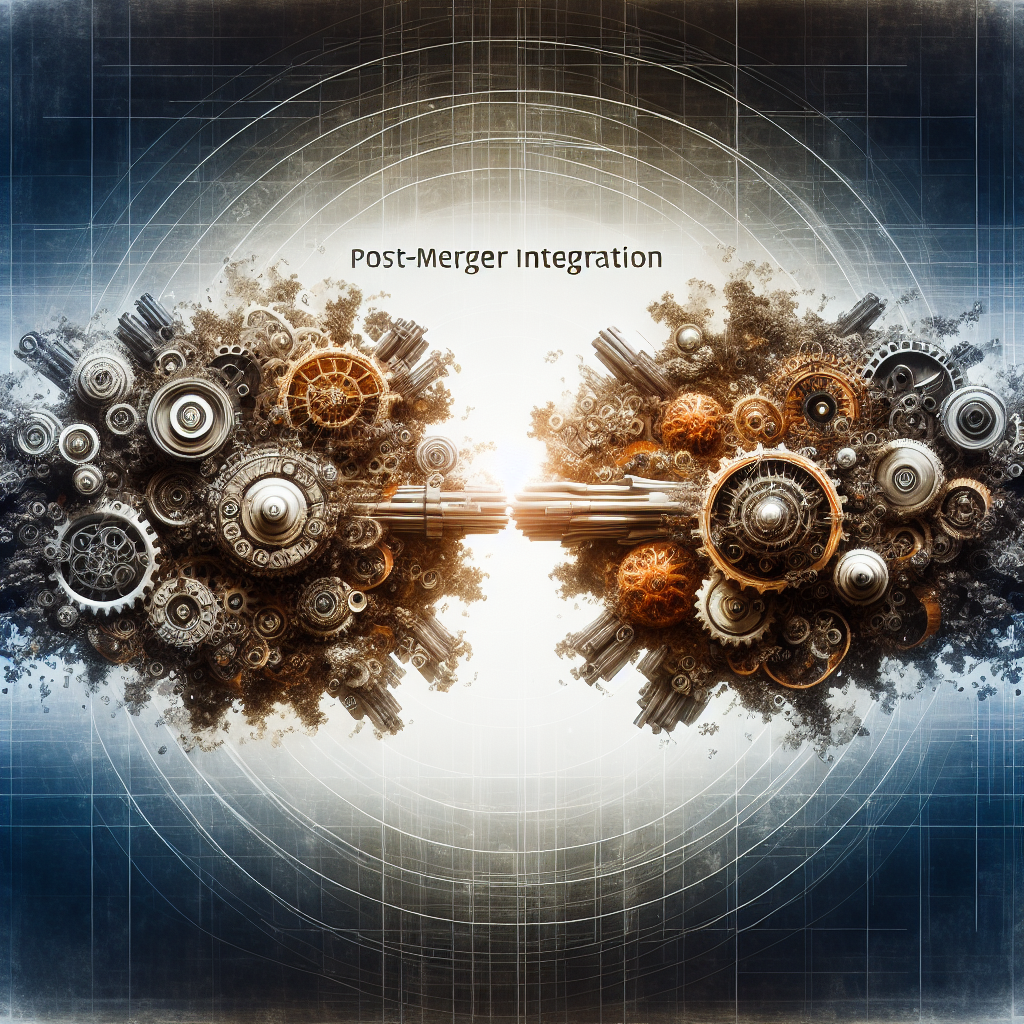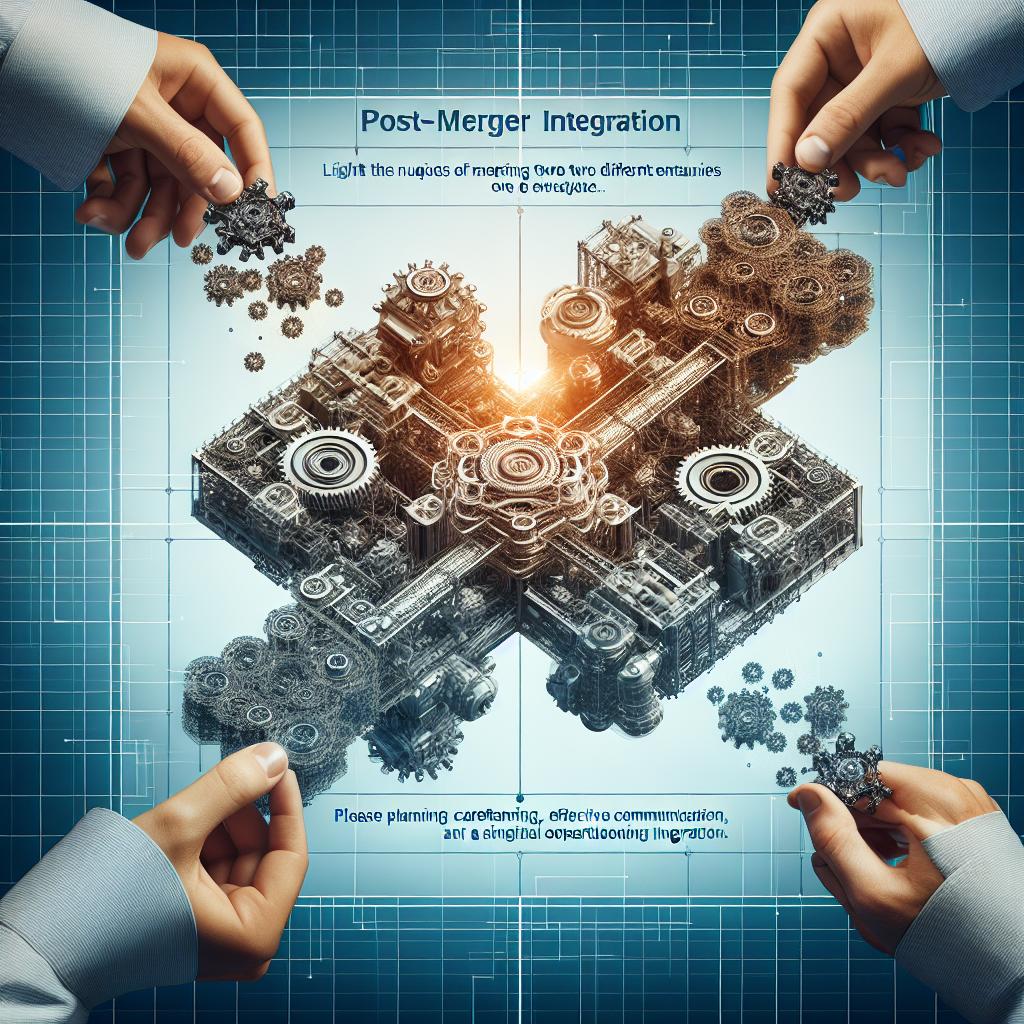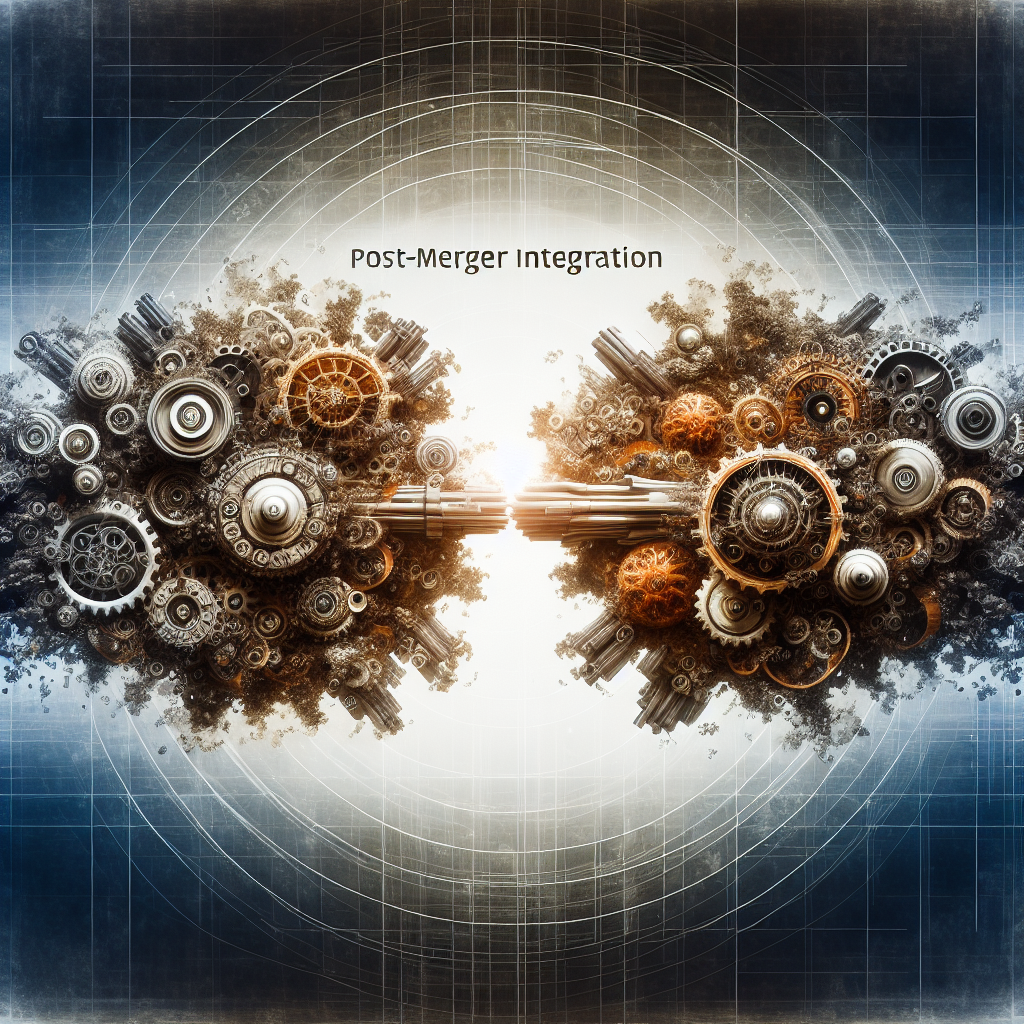Post-Merger Integration: Ensuring Smooth Operational Integration Post-merger.

In the ever-evolving landscape of business, mergers and acquisitions have become commonplace. However, the success of these ventures relies heavily on how well integration is executed post-merger. In order to ensure a seamless transition and maintain operational efficiency, organizations must strategically plan and implement a comprehensive post-merger integration strategy. This article explores the key considerations and tactics for achieving smooth operational integration in the aftermath of a merger, aiming to help decision-makers navigate this critical stage in their organization’s growth.

Setting the Stage for Post-Merger Integration
Establishing clear objectives and goals
The success of a post-merger integration largely depends on having clear objectives and goals in place from the very beginning. Prior to the merger, it is crucial for the companies involved to align their visions and define what they hope to achieve through the integration process. These objectives should be specific, measurable, attainable, relevant, and time-bound (SMART). By setting clear objectives and goals, the organizations can create a roadmap for the integration process and ensure that all efforts are focused on achieving the desired outcomes.
Creating a detailed integration plan
A comprehensive integration plan is crucial for a smooth operational integration post-merger. The plan should outline the specific steps and actions required to integrate the different aspects of the organizations, such as organizational structure, culture, leadership, employees, IT systems, finances, operations, customers, and legal compliance. Each area should be thoroughly evaluated and a plan developed to address any potential challenges or conflicts that may arise during integration. The integration plan should also include a timeline and responsibility matrix to ensure accountability and track progress throughout the process.
Developing a communication strategy
Effective communication is essential throughout the post-merger integration process. It is important to keep all stakeholders informed and engaged, including employees, customers, suppliers, and regulatory bodies. A communication strategy should be developed to outline how information will be disseminated, who will be responsible for communicating key messages, and what channels will be used. Transparent and timely communication can help alleviate concerns, address uncertainties, and foster a sense of trust and collaboration among all parties involved in the integration.
Organizational Structure and Culture
Analyzing existing organizational structures
Before integrating two organizations, it is crucial to thoroughly analyze their existing organizational structures. This analysis will help identify any overlaps or inefficiencies that may exist and aid in creating a streamlined and efficient structure post-merger. By understanding the strengths and weaknesses of each organization’s structure, it becomes possible to leverage the best practices from each and create a new structure that supports the goals and objectives of the merged entity.
Identifying potential conflicts and overlaps
When two organizations merge, there is a possibility of conflicts and overlaps arising between different roles, responsibilities, and reporting lines. It is important to identify these potential conflicts and overlaps early on to avoid disruption and confusion during the integration process. By proactively addressing these issues, organizations can develop strategies to reconcile any differences and ensure a smooth transition.
Aligning cultures and values
Organizational culture plays a significant role in the success of any integration. Therefore, it is essential to assess the cultural compatibility between the two merging companies and develop strategies to align their cultures. This may involve defining shared values, fostering open communication, and promoting collaboration and inclusivity. By actively working to align cultures, organizations can minimize resistance and create a cohesive and unified workforce.

Leadership and Management
Appointing key leaders and managers
During a post-merger integration, it is essential to appoint key leaders and managers who will drive the integration process. These individuals should possess strong leadership skills, expertise in managing change, and a deep understanding of the merged organization’s goals and objectives. Appointing the right leaders and managers will ensure effective decision-making, clear direction, and efficient execution of the integration plan.
Defining roles and responsibilities
To avoid confusion and duplication of efforts, it is crucial to clearly define the roles and responsibilities of leaders and managers post-merger. This includes identifying who will be responsible for key functions, decision-making, and overall management of the integrated organization. By establishing clear roles and responsibilities, organizations can minimize conflicts and ensure accountability throughout the integration process.
Providing training and support
The success of a post-merger integration heavily relies on the capabilities and readiness of the leaders and managers involved. It is important to provide comprehensive training and support to equip them with the necessary skills and knowledge to navigate the integration process effectively. This may involve training in areas such as change management, cultural integration, communication, and stakeholder engagement. By investing in the development of leaders and managers, organizations can enhance their ability to drive successful integration.
Employees and Workforce Integration
Addressing employee concerns and fears
During a post-merger integration, employees often experience concerns and fears related to job security, role changes, cultural shifts, and potential redundancies. It is crucial to address these concerns openly and honestly, providing employees with the information and support they need to navigate the changes. This may involve regular communication, town hall meetings, Q&A sessions, and employee assistance programs. By addressing employee concerns, organizations can minimize resistance, maintain morale, and build a sense of trust and loyalty among the workforce.
Facilitating open communication and dialogue
Open communication is vital throughout the integration process. It is important to provide employees with platforms and channels to express their thoughts, concerns, and ideas. This may involve establishing feedback mechanisms, conducting surveys, and implementing regular check-ins with employees. By fostering open communication and dialogue, organizations can gain valuable insights, address issues proactively, and ensure that employees feel heard and valued in the integration process.
Implementing a fair and transparent integration process
To maintain employee trust and engagement, it is essential to implement a fair and transparent integration process. This includes ensuring that decisions related to job placements, promotions, and redundancies are made based on objective criteria and communicated clearly to the employees. It is important to provide employees with visibility into the integration process, timelines, and any potential impacts on their roles and responsibilities. By being transparent and fair, organizations can minimize uncertainty, maintain morale, and retain key talent.

Information Technology Integration
Assessing IT infrastructure and systems
As part of the post-merger integration process, it is crucial to assess the IT infrastructure and systems of the merging organizations. This assessment helps identify any gaps or redundancies and determines the overall compatibility of the IT systems. It is important to evaluate factors such as hardware, software, networks, data storage, and cybersecurity measures. By understanding the IT landscape, organizations can develop a comprehensive plan to integrate and optimize their IT systems efficiently.
Developing a comprehensive IT integration plan
Based on the assessment of the IT landscape, it is necessary to develop a comprehensive IT integration plan. This plan should outline the specific steps and actions required to integrate the IT systems of the merging organizations. It should include considerations such as data migration, system integration, software standardization, and user training. By having a well-defined IT integration plan, organizations can minimize disruptions and ensure the seamless flow of information and operations.
Ensuring data security and privacy
Data security and privacy are of utmost importance in any post-merger integration. Organizations must ensure that appropriate measures are in place to protect sensitive information and comply with relevant regulations. This may involve conducting security audits, implementing robust cybersecurity protocols, and providing training to employees on data handling and protection. By prioritizing data security and privacy, organizations can build trust with their customers, employees, and other stakeholders.
Financial Integration
Consolidating financial systems and processes
During a post-merger integration, it is crucial to consolidate the financial systems and processes of the merging organizations. This may involve aligning accounting software, financial reporting standards, budgeting processes, and financial controls. By consolidating financial systems and processes, organizations can streamline operations, improve efficiency, and ensure accurate financial reporting.
Aligning accounting practices and policies
To ensure consistency and clarity in financial reporting, it is important to align the accounting practices and policies of the merging organizations. This includes establishing common procedures for revenue recognition, expense allocation, asset valuation, and financial statement preparation. By aligning accounting practices and policies, organizations can minimize confusion, improve transparency, and comply with regulatory requirements.
Managing financial risks and challenges
A post-merger integration often presents financial risks and challenges that need to be effectively managed. These risks may include cash flow disruptions, increased debt levels, currency fluctuations, or changes in tax obligations. It is important to conduct a thorough risk assessment and develop strategies to mitigate and manage these risks. This may involve working closely with financial advisors, conducting scenario analysis, and implementing appropriate risk management measures. By proactively managing financial risks, organizations can safeguard their financial stability and ensure long-term success.

Operations and Supply Chain Integration
Streamlining operations and processes
Post-merger integration provides an opportunity to streamline operations and processes across the merged entities. This may involve identifying redundancies, eliminating inefficiencies, and implementing best practices. By optimizing operations, organizations can achieve cost savings, improve productivity, and enhance overall performance.
Optimizing the supply chain network
An important aspect of post-merger integration is optimizing the supply chain network. This may involve consolidating suppliers, renegotiating contracts, and centralizing procurement processes. By optimizing the supply chain, organizations can achieve economies of scale, reduce costs, and enhance supply chain resilience.
Identifying cost-saving opportunities
Post-merger integration provides an opportune time to identify and capitalize on cost-saving opportunities. This may involve analyzing cost structures, renegotiating vendor contracts, and implementing process improvements. By actively seeking cost-saving opportunities, organizations can improve profitability and generate value from the merger.
Customer and Client Integration
Managing customer relationships and expectations
During post-merger integration, it is crucial to proactively manage customer relationships and expectations. This may involve conducting customer surveys, hosting focus groups, and providing personalized communication to address their concerns. By actively managing customer relationships, organizations can retain customer loyalty, mitigate customer churn, and ensure a smooth transition.
Ensuring a seamless customer experience
One of the key goals of post-merger integration is to ensure a seamless customer experience. This requires integrating customer-facing processes, systems, and teams to deliver consistent and high-quality service. By providing a seamless customer experience, organizations can enhance customer satisfaction, loyalty, and advocacy.
Retaining and expanding the client base
Post-merger integration presents an opportunity to retain and expand the client base. Organizational efforts should be focused on building strong relationships with existing clients and leveraging cross-selling and upselling opportunities. Additionally, organizations should identify potential new clients and develop strategies to win their business. By effectively managing the client base, organizations can drive revenue growth and maximize the value of the merger.

Legal and Regulatory Compliance
Evaluating legal and regulatory requirements
Post-merger integration requires a careful evaluation of the legal and regulatory requirements that may apply to the merged organization. This includes compliance with antitrust laws, securities regulations, labor laws, and intellectual property rights. It is important to conduct a comprehensive legal and regulatory assessment and develop strategies to ensure compliance.
Addressing compliance issues and risks
During post-merger integration, it is crucial to address any compliance issues and risks that may arise. This may involve conducting audits, implementing control mechanisms, and providing compliance training to employees. By addressing compliance issues and risks, organizations can protect their reputation, avoid legal penalties, and maintain stakeholder trust.
Securing necessary approvals and licenses
Post-merger integration may require obtaining necessary approvals and licenses from regulatory bodies. It is important to proactively engage with regulators and ensure compliance with all applicable laws and regulations. By securing necessary approvals and licenses, organizations can operate legally and prevent any disruptions to their operations.
Monitoring and Evaluation
Establishing key performance indicators
To assess the progress and effectiveness of post-merger integration, it is important to establish key performance indicators (KPIs). These KPIs should align with the objectives and goals set during the initial stage of integration. By monitoring and tracking KPIs, organizations can evaluate the success of the integration process and make necessary adjustments as needed.
Regularly reviewing integration progress
Post-merger integration is an ongoing process that requires regular review and evaluation. It is important to establish a cadence for reviewing integration progress and identifying any deviations from the integration plan. This may involve conducting periodic audits, assessing performance against established KPIs, and seeking feedback from stakeholders. By regularly reviewing integration progress, organizations can identify areas for improvement and take corrective actions to ensure the successful integration of the merged entities.
Making necessary adjustments
Post-merger integration is a dynamic process that may require adjustments along the way. It is important to be agile and responsive to changing circumstances and make necessary adjustments to the integration plan as needed. By adapting to new challenges and opportunities, organizations can enhance the overall effectiveness and outcomes of the post-merger integration.
In conclusion, ensuring smooth operational integration post-merger requires careful planning and execution across various dimensions, including objectives and goals, organizational structures, leadership and management, employees and workforce, IT integration, financial integration, operations and supply chain, customer and client integration, legal and regulatory compliance, and monitoring and evaluation. By addressing each of these areas in a comprehensive and strategic manner, organizations can overcome challenges, maximize synergies, and achieve a successful post-merger integration.







